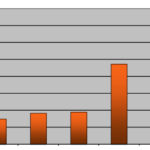High-Pressure-Steam-Heat-Exchanger-269
Background
As part of a Reliability Excellence implementation in a large alumina refinery, Life Cycle Engineering, Inc. (LCE) assigned a Reliability Engineer to investigate potential limiting factors that could be resolved short-term. The intent of these Reliability Action Team (R.A.T.) activities is twofold. First, to begin the change process by getting the workforce involved in resolving problems that negatively affect the plant. The added benefit of these activities is the generation of immediate improvement in plant performance and financial profitability.
The team’s analysis of plant data identified excessive maintenance and repair costs on 10 High-Pressure-Steam (HPS) Heat Exchangers. Each of these heat exchangers contains 906 straight-through tubes that convey slurry through the exchanger. The slurry extracts heat from the live steam on the shell-side as it passes through the heaters to sustain a chemical reaction. Each of the heaters was taken out of service after forty days of operation, inspected for tube plugging and any observed tube was removed and replaced with a new one. Historical annual cost of this practice was more than $500,000.
Actions Taken
Following the R.A.T. analysis the following changes were implemented:
Mechanical and Chemical Cleaning vs. Replacement
Evaluation of the process and maintenance methods determined that the heat exchanger tubes could be mechanically cleaned and did not need to be replaced. In addition, first mechanically removing buildup inside the tubes and then chemically flushing them would improve thermal efficiency and the heat transfer capabilities of the heat exchangers. The maintenance procedure was changed to “clean” rather than “replace” plugged tubes.
Performance-based vs. Elapsed-time Maintenance Schedule
In addition, the evaluation determined that the heat exchangers did not need to be removed from service at the arbitrary forty day interval. Data confirmed that less than ten percent of the tubes were plugged after forty days of continuous service and this loss did not affect thermal efficiency of the heat exchangers. The elapsed-time preventive and outage maintenance schedule has been replaced with a performance monitoring program that schedules preventive maintenance tasks or re-tubing outages based on loss of thermal efficiency and pressure-drop across the heat exchangers.
The Results
The recommended changes were implemented and in five months of 2007 generated $95,000 in savings from substituting mechanical cleaning instead of replacement. Annualized, this represents an annual savings of $407,000.
The client is using the saved money to partially fund their engagement with LCE, and to bolster the profit margin during the economic down-turn.
The client is planning several other R.A.T. projects, each with ROI of between 3 and 5:1.

A secondary benefit achieved from the mechanical and chemical cleaning is a 3% to 5% increase in thermal or heat transfer efficiency following the preventive maintenance visit. In the past, operations could not quantify any improvement in heat exchanger performance following maintenance, and in some cases noted a decrease in overall performance.
© 2010 Life Cycle Engineering, Inc
For More Information
843.744.7110 | info@LCE.com















